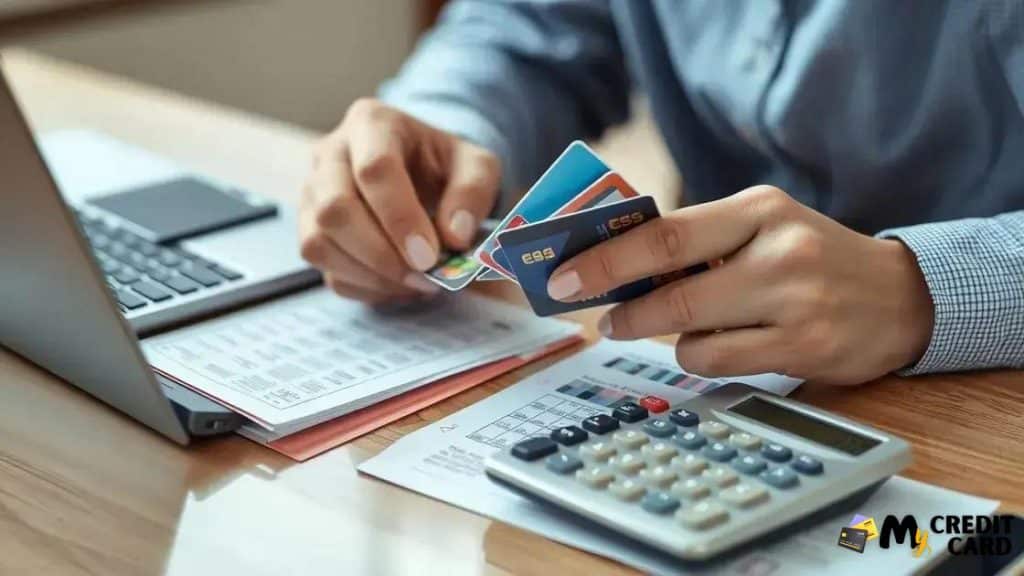How to reduce credit card debt in 2025 effectively

Anúncios

Credit card debt can feel like a shadow that follows you everywhere, especially in 2025, when rising interest rates and inflation make it even harder to get ahead. But here’s the good news: you’re not powerless.
With the right mindset and actionable steps, you can take back control of your finances and start building a debt-free future.
Anúncios
Below, we’ll guide you through practical and proven strategies to understand, manage, and eliminate credit card debt—starting today.
Understanding Credit Card Debt: The Foundation of Financial Recovery
To overcome credit card debt, the first and most important step is understanding how it works. Many people carry balances from month to month without realizing how quickly small amounts can grow into overwhelming financial burdens.
As of 2025, Americans hold over $1 trillion in credit card debt, and the average APR has exceeded 20%, making unpaid balances more expensive than ever.
Anúncios
This debt often builds silently, driven by everyday purchases, emergency expenses, or minimum payments that barely make a dent in the balance. The danger isn’t just in the amount owed, it’s in how quickly it grows when left unmanaged.
What Exactly Is Credit Card Debt?
Credit card debt is the unpaid amount you owe to your credit card issuer after making purchases. When you don’t pay the full balance by the due date, interest is added to what you owe.
This is different from other types of debt because it’s revolving, you can keep using the credit line and repaying it repeatedly, as long as you stay within your limit.
However, this flexibility often leads to poor spending habits, especially when there’s no structured repayment plan. Over time, even small balances can grow due to compounding interest and fees.
How Interest Turns Small Balances Into Big Problems
Interest is the core reason why credit card debt becomes hard to eliminate. Unlike a traditional loan, credit card interest compounds daily. That means every day you carry a balance, your debt increases a little more.
For those making only the minimum payment, most of that money goes toward interest, not the principal. This can stretch repayment across years, turning a $1,000 balance into thousands more over time.
Many cards also have different interest rates for purchases, cash advances, and balance transfers.
For example, cash advances typically have no grace period and start accumulating interest immediately, often at higher rates than standard purchases. This makes them one of the most expensive forms of credit.
Types of Credit Card Debt: More Than Just Purchases
It’s important to know that credit card debt isn’t always the same. Purchases made with your card are the most common source, but they aren’t the only one.
Cash advances, for instance, allow you to withdraw money directly from your card, but they come with extra fees and higher interest rates. Some cards also allow installment plans for large purchases, where you pay in fixed monthly amounts.
While this can offer more control, missing a single payment can lead to penalties and increased interest.
By identifying what kind of debt you have, you can create a smarter, more effective payoff strategy. For example, tackling high-interest cash advances first can help reduce long-term costs, while installment plans may allow for more predictable budgeting.
Why This Understanding Matters
Knowing how credit card debt works is more than just a financial lesson, it’s a tool for change. Once you see where the money goes, how interest accumulates, and which debts cost you more, you can make informed decisions.
Whether you choose to pay off your highest-interest card first or explore debt consolidation, your plan starts with awareness.
Understanding your debt also helps you avoid emotional stress. Instead of feeling overwhelmed, you begin to see opportunities for improvement and progress. That shift in mindset is what turns financial chaos into confidence, and debt into freedom.
Key strategies to lower credit card balances
Reducing credit card debt is not just about paying off what you owe. It’s about changing your approach to money, taking back control of your financial life, and creating habits that keep you out of debt for good.
Carrying large balances for long periods drains your income through high interest and limits your ability to plan for the future.
Recent data shows that many households make only the minimum payment each month, which often leads to repayment periods that stretch over a decade.
To avoid this trap, you need a proactive plan that addresses both your budget and your repayment behavior.
Create a Budget
The first step to lowering your credit card debt is creating a clear and realistic monthly budget. Budgeting gives you visibility over your income and expenses, helping you make informed decisions.
When you know exactly how much you spend and where, you can identify areas to cut back and redirect that money toward debt repayment.
This might mean reducing small, frequent expenses such as food delivery, unused subscriptions, or spontaneous purchases. Even modest adjustments, when applied consistently, can free up funds to make larger payments on your credit cards.
Make More Than the Minimum Payment
Paying only the minimum on your credit cards can lead to a mountain of debt. Whenever possible, aim to make larger payments.
This will help reduce the amount of interest you accumulate, enabling you to pay off your balance faster. Even an extra $20 can make a difference.
- Paying more reduces your balance faster.
- It can also help improve your credit score.
- Focus on the card with the highest interest rate first.
Additionally, some credit cards offer promotional rates, which can allow you to save on interest during a large purchase. Knowing these options can contribute to your strategy.
Consider consolidating your debt by transferring your balance to a card with a lower interest rate. This approach can help simplify payments and save money in interest over time. If you choose this route, be aware of balance transfer fees.
Use Windfalls Wisely
Whenever you receive unexpected money, like a bonus or tax refund, consider putting it towards your credit card balances. Using these windfalls can have a significant impact on reducing your overall debt.
Combining these strategies will make a real difference in paying down your credit card debt. By being proactive and intentional, you can regain control of your finances and work towards a debt-free future.
Applying Extra Income Strategically
Receiving a tax refund, work bonus, or freelance income is a great opportunity to make significant progress on your credit card debt.
Rather than using that money on short-term wants, apply it directly to your highest balance or to reduce your overall debt burden.
These lump-sum payments help lower your principal faster, which also means you’ll pay less interest over time. Even occasional payments like this can break the cycle of slow progress and renew your momentum.
Building a Consistent, Long-Term Approach
Paying down credit card balances is not something that happens overnight, but consistency will get you there.
By combining intentional budgeting, higher monthly payments, smart use of promotional offers, and strategic use of extra income, you’ll make real progress.
Small, consistent efforts often outperform sudden drastic changes. The key is to stay focused, adjust your plan as your financial situation evolves, and keep your eyes on the long-term goal: freedom from credit card debt.
The Importance of Budgeting Effectively to Reduce Credit Card Debt

Budgeting effectively is one of the most powerful tools you can use to regain control of your financial life.
When you’re dealing with credit card debt, a well-organized budget allows you to manage spending, reduce unnecessary expenses, and allocate funds directly toward what matters most, paying down your balances.
Many individuals fall into debt simply because they lack a clear picture of their income versus their expenses.
Without this awareness, it becomes easy to overspend and rely on credit cards to fill financial gaps. Budgeting changes that by creating structure and clarity.
Why Budgeting Matters
When you budget, you gain insight into your spending habits. This insight allows you to make informed decisions about where to cut back. Knowing how much you spend can help you allocate funds towards paying off your credit card debt.
With a budget, you can prioritize what matters most to you, whether that’s savings, investments, or paying down debt.
Setting Financial Goals
Creating a budget also helps in setting clear financial goals. By identifying both short-term and long-term objectives, you can stay focused and motivated. Here are some goals to consider:
- Paying off a specific credit card.
- Saving for an emergency fund.
- Setting aside money for a vacation or a major purchase.
These goals keep you accountable and guide your spending decisions. Without goals, it can feel easy to drift away from your financial priorities. Keeping your goals visible helps maintain motivation.
Tracking Your Progress
An effective budget gives you the tools to track your progress. This means adjusting your budget as needed to reflect changes in income or expenses. It’s essential to revisit your budget regularly.
Checking in allows you to see if you’re meeting your financial goals and adapting to any new circumstances.
Moreover, a budget makes it easier to identify unnecessary expenses. If you notice you’re spending too much on dining out or entertainment, you can make quick adjustments.
This flexibility is key to maintaining financial stability while reducing your credit card balances.
Ultimately, understanding and embracing the importance of budgeting effectively can lead to better financial decisions. The more you budget, the more control you will have over your financial future.
Negotiating with creditors for better terms
Negotiate may sound like a stressful word, especially when it comes to money. But for many people struggling with credit card debt, reaching out to creditors and requesting better terms is not only possible—it can be a game-changer.
With the right approach and preparation, you can reduce interest rates, eliminate late fees, and create a payment plan that actually fits your reality.
Lenders would much rather receive some payment than none at all, and most credit card companies have dedicated departments to handle financial hardship situations.
That means you have more room to negotiate than you might think.
Preparation is Key
Before starting negotiations, gather all relevant information about your accounts. Understand how much you owe and the interest rates associated with each card. Being informed will give you confidence during discussions. Here are some tips:
- Know your current balance and payment history.
- Research the creditor’s policies on negotiations.
- Prepare a clear explanation of your financial situation.
This preparation helps make your case stronger. It shows creditors that you are serious about resolving your debts and willing to work together towards a solution.
Making the Call: What to Say and How to Say It
Once you’re prepared, it’s time to contact your creditor. Always approach the conversation calmly and professionally.
Explain your current financial hardship and make it clear that you are committed to repaying what you owe, but need some assistance to make that happen.
Many customer service representatives are authorized to offer modified terms, especially if you have a good payment history.
You can ask for a lower APR to reduce the cost of your credit card debt, or request extended payment terms that give you more time and flexibility.
Some creditors may even pause or reduce payments temporarily through hardship plans without damaging your credit.
If the first person you speak to can’t help, politely ask to be transferred to someone who handles hardship cases. Persistence and politeness can go a long way in these situations.
Following Up and Documenting the Agreement
After any conversation with a creditor, it’s crucial to get everything in writing. Ask for written confirmation of any changes agreed upon, such as new interest rates, payment terms, or waived fees.
Keep all emails, letters, or documents related to the negotiation, as these can protect you later if misunderstandings arise.
Maintaining a record of communication also keeps you accountable. If the creditor agrees to reduce your payment temporarily, you’ll need to stick to that agreement to continue receiving those benefits.
Long-Term Benefits of Negotiating Your Debt
While not every creditor will agree to modify your terms, many do. Even a small reduction in interest can save you a significant amount over time. A more manageable payment structure also helps prevent missed payments and protects your credit score.
Most importantly, negotiating gives you a sense of control during a time when debt can feel overwhelming. It shows that you’re taking responsibility and actively working toward a solution.
For many, this is the turning point that shifts them from reactive to proactive financial behavior.
By negotiating smartly and documenting every step, you can build a path out of credit card debt that is realistic and sustainable, without defaulting or falling deeper into financial stress.
Exploring debt consolidation options
Consolidating your debt can be a powerful way to regain control of your finances, especially when juggling multiple credit cards and high-interest rates.
If you’re overwhelmed by different payment dates, varying interest rates, and growing balances, exploring debt consolidation may offer the clarity and simplicity you need to move forward with confidence.
Credit card debt becomes more manageable when it’s combined into a single, structured payment.
Rather than keeping track of multiple accounts and minimum payments that barely reduce your balances, consolidation allows you to focus on one monthly installment, often with a lower interest rate.
What is Debt Consolidation?
Debt consolidation is the process of taking out a new credit product, such as a personal loan, balance transfer card, or home equity loan, and using it to pay off your existing debts.
The goal is to streamline your payments and reduce the total interest you pay over time.
For example, if you have three credit cards charging 22 percent interest and you consolidate them into a loan with a 12 percent rate, you’re immediately saving money just by restructuring your debt.
In addition to financial savings, many people find that having just one due date makes budgeting simpler and less stressful.
Types of Debt Consolidation
There are several types of debt consolidation options to consider:
- Personal Loans: These loans give you a lump sum of money to pay off your debts. They usually have fixed interest rates.
- Balance Transfer Credit Cards: These allow you to transfer your existing credit card balances to a new card with a lower interest rate.
- Home Equity Loans: If you own a home, you can tap into your equity to consolidate your debts at lower rates.
Each option has its pros and cons, depending on your financial situation and credit score.
Benefits of Debt Consolidation
One of the main advantages of debt consolidation is the simplification of your payments. Instead of remembering multiple due dates, you only have to track one monthly payment. This can ease stress and improve your financial organization.
Additionally, lowering your interest rate can save you money over time. If you’re consistently late on payments, consolidating your debt might help improve your credit score as well.
Things to Consider
While debt consolidation can be beneficial, it’s essential to weigh the options carefully. Make sure to review the terms and conditions of any loan or credit card.
Be aware of any fees associated with consolidation, and avoid falling back into debt by using your credit cards after consolidation.
Ultimately, exploring debt consolidation options can be a vital step in reclaiming your financial health. Understanding your choices will empower you to make the best decision for your future.
Where to Learn More About Debt Consolidation
If you’re considering this path, it’s crucial to do your research. This guide on debt consolidation as a financial solution offers a detailed breakdown of the pros, cons, and decision-making steps involved.
It can help you evaluate whether this approach matches your current financial needs.
Debt consolidation can be a highly effective way to reduce credit card debt, simplify repayment, and build momentum toward financial freedom, especially when paired with strong budgeting habits and a long-term plan.
Building better financial habits for the future

Developing strong financial habits is one of the most reliable ways to protect yourself from future financial stress. For anyone dealing with credit card debt, these habits are not just helpful, they are essential.
While debt reduction strategies can provide temporary relief, it’s the habits you build over time that determine whether you’ll stay debt-free in the long run.
Many people fall into debt not because they overspend dramatically, but because they lack consistent practices around saving, planning, and tracking. Changing your financial behavior doesn’t require perfection.
It requires awareness, discipline, and a willingness to make small changes that compound over time.
Creating a Savings Plan
One of the first steps to building better financial habits is establishing a savings plan. Setting aside money regularly can help you cover unexpected expenses and reduce your reliance on credit cards. Aim to save a specific percentage of your income each month.
- Start with a small, manageable amount.
- Increase your savings as your financial situation improves.
- Use automatic transfers to make saving easier.
By having a dedicated savings plan, you can focus less on borrowing money and more on financial stability.
Gaining Control Through Expense Tracking
Understanding where your money goes is one of the most powerful habits you can build. When you track expenses daily or weekly, you uncover patterns that might otherwise go unnoticed.
It’s common to be surprised by how much is spent on small, recurring items like coffee, food delivery, or streaming subscriptions.
By identifying these leaks in your budget, you can redirect those funds toward your goals—especially toward eliminating credit card debt.
There’s a sense of empowerment that comes with knowing you’re choosing how to spend, rather than letting your money slip through your fingers without awareness.
Growing Your Financial Knowledge
No long-term improvement is sustainable without a solid understanding of how money works. Financial literacy helps you avoid common mistakes, choose the right financial products, and make confident decisions about saving, borrowing, and investing.
Learning about topics like compound interest, debt repayment strategies, budgeting methods, and credit scores will prepare you to handle money more effectively.
You can read reputable personal finance blogs, watch videos, take free online courses, or attend community workshops. The more informed you are, the more likely you are to avoid the habits that lead to high-interest debt and poor financial outcomes.
Setting and Reaching Realistic Financial Goals
Strong habits are easier to maintain when you have a clear goal.
Whether you want to eliminate a specific credit card balance, build a three-month emergency fund, or save for your first investment, defining your target keeps you focused and motivated.
The most effective goals are specific and measurable. Instead of saying “I want to save money,” say “I want to save R$1.000 in six months to avoid using my credit card for emergencies.”
Breaking goals into smaller monthly or weekly milestones gives you a clear sense of progress and reinforces your commitment.
Building Habits That Protect Your Future
Good financial habits are like muscles, they get stronger the more you train them. Saving regularly, tracking your spending, making informed decisions, and setting clear goals can transform your relationship with money.
These practices help prevent future credit card debt and give you the freedom to focus on what matters most in your life.
It’s not about living a life of constant restriction, but about creating financial stability that lets you breathe easier, sleep better, and prepare for opportunities without fear.
Your future financial health depends on what you do today, so the sooner you begin building better habits, the stronger and more secure that future will be.
Final Thoughts: A Clear Path Toward Financial Freedom
Eliminating credit card debt takes time, discipline, and a strategy tailored to your financial reality, but it is absolutely achievable.
Whether you’re overwhelmed by interest charges, stuck making only minimum payments, or managing multiple balances, the key is to take steady and consistent action.
Start by understanding the root causes of your credit card debt, then create a realistic budget that prioritizes repayment.
Don’t hesitate to negotiate with creditors, consolidate what you owe, or apply extra income toward reducing your credit card debt faster.
At the same time, focus on building financial habits that will protect you from falling back into credit card debt in the future. Habits like saving regularly, tracking expenses, and improving your financial knowledge all contribute to long-term stability.
If you want expert guidance, NerdWallet offers a full breakdown of proven strategies, tools, and insights to help you manage and eliminate credit card debt effectively.
Additionally, Bank of America’s Better Money Habits platform provides step-by-step tips for paying off credit card debt faster, with real-life examples and practical advice.
The journey to a debt-free life begins with a single step. And with each action you take, you’re not just reducing credit card debt, you’re building peace of mind, financial freedom, and a future that’s no longer controlled by balances and interest rates.
FAQ – Frequently Asked Questions about Reducing Credit Card Debt in 2025
What is the first step to reducing credit card debt?
The first step is to understand how much you owe. List your debts and the interest rates to get a clear picture.
How can creating a budget help with debt management?
Creating a budget helps you track your spending and allocate funds toward paying off your credit card debt effectively.
What are the benefits of debt consolidation?
Debt consolidation can simplify payments and may lower your overall interest rates, making it easier to manage debt.
How do better financial habits contribute to debt reduction?
Building better financial habits, like saving regularly and tracking expenses, reduces reliance on credit and helps pay down debt faster.
Liked the article?





